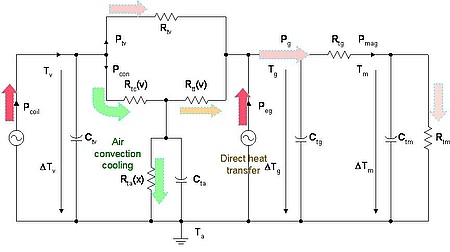Thermal Parameter Measurements
Characteristics: | KLIPPEL R&D System |
|---|---|
Thermal resistances of voice coil and magnet
| LSI (for DA), PWT |
Thermal capacities of voice coil and magnet
| LSI (for DA), PWT |
Air convection cooling coefficient
| LSI (for DA), PWT |
Eddy current heating factor | LSI (for DA), PWT |
Most electro-acoustical transducers have low efficiency and convert most of the electrical energy into heat. Thus, the heating of the coil limits the power handling and the maximal output of the transducer. The thermal dynamics can be modeled by an equivalent circuit comprising thermal resistances, capacities and power sources. A low voice coil resistance Rtv, a high capacity Ctv and a high bypass factor due to forced convection cooling in the nonlinear resistance Rtc(v) support the cooling of the voice coil.
KLIPPEL R&D SYSTEM (development)
Module | Comment |
|---|---|
LSI (for DA) provides a special thermal identification mode which identifies the dominant thermal parameters automatically. The measurement consists of ON/OFF cycles using different noise stimuli. The input power and the measurement time is automatically adjusted to the particular transducer. All state variables (temperature, displacement, input power, voltage and current) are monitored during the measurement. | |
PWT does not provide the thermal parameters directly but gives voice coil temperature and input power versus measurement time. Additional post-processing is required to calculate the thermal parameters (details are described in the paper about nonlinear thermal modeling by KLIPPEL 2004). |
Templates of KLIPPEL products
Name of the Template | Application |
|---|---|
Diagnost. MIDRANGE Sp1 | Comprehensive testing of midrange drivers with a resonance 30 Hz < fs < 200 Hz using standard current sensor 1 |
Diagnost. SUBWOOFER (Sp1) | Comprehensive testing of subwoofers with a resonance 10 Hz < fs < 70 Hz using standard current sensor 1 |
Diagnostics MICROSPEAKER Sp2 | Comprehensive testing of microspeakers with a resonance 100 Hz < fs < 2 kHz using sensitive current sensor 2 |
Diagnostics TWEETER (Sp2) | Comprehensive testing of tweeters with a resonance 100 Hz < fs < 2 kHz using sensitive current sensor 2 |
Diagnostics VENTED BOX SP1 | Comprehensive testing of vented box systems using standard current sensor 1 |
Diagnostics WOOFER (Sp1) | Comprehensive testing of subwoofers with a resonance 30 Hz < fs < 200 Hz using standard current sensor 1 |
Diagnostics WOOFER Sp1,2 | Comprehensive testing of subwoofers with a resonance 30 Hz < fs < 200 Hz using current sensor 1 and 2 |
Thermal Parameters (woofer) | Analysis of heat transfer in woofers based on identified thermal woofer parameters |
Thermal Parameters AN 18 | Thermal Parameters measured by using PWT module according Application Note 18 |
Thermal Parameters AN 19 | Thermal Parameters measured by using PWT module according Application Note 19 |
LSI Woofer Nonl.+Therm. Sp1 | Nonlinear and thermal parameters of woofers with fs < 300 Hz at standard current sensor Sp1 |
LSI Woofer+Box Nonl. P Sp1 | Nonlinear parameters of woofers operated in free air, sealed or vented enclosure with a resonance frequency fs < 300 Hz at standard current sensor Sp1 |
SIM Therm. Analysis (1 tone) | Heat transfer based on thermal parameters imported from LSI using a single-tone stimulus |
SIM Therm. Analysis (2 tone) | Heat transfer based on thermal parameters imported from LSI using a two-tone stimulus |
PWT Powtest (fast Temp.) | Power test for fast monitoring of temperature, power and resistance without parameter measurement using external continuous signal (noise) supplied to IN1 |
PWT Powtest SWEEP | Power test for measuring the thermal time constant of the voice coil using sweep signal with low crest factor |
PWT Powtest TIME Const. | Power test for measuring time constant of voice coil using internal test signal with cycling (ON/OFF phase) |
Standards
Audio Engineering Society
AES2 Recommended practice Specification of Loudspeaker Components Used in Professional Audio and Sound Reinforcement
Consumer Electronics Association
CEA-426-B Loudspeakers, Optimum Amplifier Power
European Telecommunications Standards Institute
EIA 426B Loudspeaker Power Rating Test CD provided by ALMA International
International Electrotechnical Commission
IEC 60268-5 Sound System Equipment, Part 5: Loudspeakers
Other Related Tests
Typical Test Objects
Papers and Preprints
W. Klippel, “Nonlinear Modeling of the Heat Transfer in Loudspeakers,” J. of Audio Eng. Soc. 52, Volume 1, 2004 January.
Y. Shen, “Accelerated Power Test Analysis Based on Loudspeaker Life Distribution,” presented at the 124th Convention of Audio Eng. Soc., May 2008, Preprint 7345.
C. Zuccatti, “Thermal Parameters and Power Ratings of Loudspeakers,” J. of Audio Eng. Soc., Volume 38, No. 1, 2, 1990 January/February.
P. J. Chapman, “Thermal Simulation of Loudspeakers,” presented at the 104th Convention of Audio Eng. Soc., May 1998, Preprint 4667.
G. Behler, A. Bernhard, “Measuring Method to derive the Lumped Elements of the Loudspeaker Thermal Equivalent Circuit,” presented at the 104th Convention of Audio Eng. Soc., 1998 May 16-19, Amsterdam, Preprint 4744.
G. Behler, “Measuring the Loudspeaker's Impedance During Operation for the Derivation of the Voice Coil Temperature,” presented at the 98th Convention of Audio Eng. Soc.,1995 February 25-28, Paris, Preprint 4001.
K. M. Pedersen, “Thermal Overload Protection of High Frequency Loudspeakers,” Report of Final Year Dissertation at Salford University.
Henricksen, “Heat Transfer Mechanisms in Loudspeakers: Analysis, Measurement and Design,” J. of Audio Eng. Soc., Volume 35, No. 10, 1987 October.

